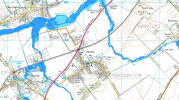Nottingham59
Established Member
One of the criteria for new housing is the provision of adequate public transport links. Indeed, the rationale for East-West Rail is to enable large developments at places like Cambourne.
Labour is promoting the idea of New Towns to solve the housing crisis. Rather than building new lines, where could these be located where there is already capacity on the rail network?
For what it's worth, these are my suggestions:
Labour is promoting the idea of New Towns to solve the housing crisis. Rather than building new lines, where could these be located where there is already capacity on the rail network?
For what it's worth, these are my suggestions:
- Cheddington There is already a four-platform station on the WCML at Cheddington, which is surrounded by open countryside. Use New Towns legislation to buy up all agricultural land within 2-3 miles of the station; mark out a network of covered cycleways and autonomous tramlines (like DLR) centred on the station; and build homes for 250,000 people to create a compact New Town the same population as Milton Keynes, but physically less spread out.
The WCML will have plenty of capacity when HS2 opens, and there are few neighbours to complain. And those that do are likely to vote Tory anyway, so they will have little electoral impact. - Greater Shelford Rather than building EWR to bring commuters into Cambridge from Cambourne and Tempsford, then build the houses near the existing stations like Foxton, Shepreth, Shelford, which already have Thameslink connections to Cambridge, and Whittleford Parkway. Also build new stations on existing lines, like at Fulbourn. These sites may be in the Cambridge green belt, but green belts are planning devices whose purpose is to constrain the growth of cities. If it is now government policy for cities like Cambridge to grow, then the Green Belt has lost its purpose and should be abolished.
- Rubgy One objection to any new housing in South East England is the lack of water supplies. Rugby is north of the Kilsby tunnel where the WCML crosses the great Watershed that runs across England from the Cotswolds to Lincoln. It is therefore the nearest place to London in the Severn-Trent water area, where supplies are much less scarce. It also has fast and slow line services to London on an WCML that will have much more commuter capacity after HS2.
- Lichfield. Lichfield will also enjoy unconstrained WCML capacity after HS2, from where it would be feasible to run 2tph on the fast lines non-stop to London, and 2tph semi-fast calling at stations in the Trent Valley before switching to the fasts at Rugby. It also has direct services to Birmingham and potentially Derby. When the new Lichfield gets big enough (say 300,000), then it would also make a good place for an HS2 station, being half-way between Interchange and Crewe. This would vastly increase its appeal as a commuter town. You wouldn't want to build stations on HS2 south of Birmingham, but track utilisation north of Birmingham will be lower, and therefore the timetables could accommodate another station without reducing capacity. I would locate the new station where HS2 crosses the Lichfield City line, to provide an interchange. If HS2 phase 2 ever gets built, I'd also include a new chord to the WCML so that trains from Milton Keynes and Rugby could join HS2 towards Manchester and Scotland.


 ).
).